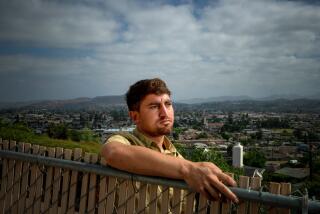An Asylum Seeker Becomes Longest Detainee
- Share via
TORONTO — The date was Sept. 12, 2001, but Benemar “Ben” Benatta was clueless about the death and destruction that had unfolded a day earlier.
About a week before, Canadian officials had stopped Benatta as he entered the country from Buffalo to seek political asylum. On Sept. 11, he was quietly transferred to a U.S. immigration lockup where a day passed before FBI agents told him what the rest of the world already knew: Terrorists had attacked the World Trade Center and the Pentagon.
It slowly dawned on Benatta that his pedigree -- a Muslim man with a military background -- made him a target in the frenzied national dragnet that soon followed. The FBI didn’t accuse him of being a terrorist -- at least not outright.
But agents kept asking if he could fly an airplane.
No, he said.
It made no difference.
“They gave me a feeling that I was Suspect No. 1,” he said in a recent interview.
The veiled accusations and vehement denials would continue for nearly five years -- despite official findings in 2001 that he had no terrorist links and in 2003 that authorities had violated his rights by colluding to keep him in custody.
Of the estimated 1,200 mostly Arab and Muslim men detained nationwide as potential suspects or witnesses in the Sept. 11 investigation, Benatta would earn a dubious distinction: Human rights groups say the former Algerian air force lieutenant was locked up the longest.
His journey through the American justice system concluded July 20 when a deal was finalized for his return to Canada. In the words of his lawyer, the idea was to “turn back the clock” to when he first crossed the border.
But time did not stand still for Benatta. The clock ran for 1,780 days. The man detained at 27 was now 32.
“I say to myself from time to time, maybe what happened ... it was some kind of dream,” he said. “I never believed things like that could happen in the United States.”
In a nation reeling from unthinkable horrors inflicted by an unconventional enemy, it could.
And it did.
*
Sporting a gray T-shirt and cargo shorts on a sizzling summer day, Benatta eased his muscular frame into a white plastic chair in the backyard of a Toronto halfway house for immigrant asylum-seekers. He sipped lemonade, then paused to taste freedom.
“You start to look around and take in everything -- the wind in your face, the breeze -- everything,” he said.
The youngest of 10 children in a middle-class family, Benatta recalled always wanting to be military man like his father. But after he joined the air force, he grew disillusioned. Algerian soldiers, he said, were abusive toward civilians. And militant Muslims were out for blood.
“I was in harm’s way in my country,” he said.
In December 2000, Benatta entered a six-month training program for foreign air force engineers in Virginia, plotting from the start to flee to Canada. In June 2001, the night before his scheduled flight back to Algeria, he stole out of a hotel. He lived briefly in New York before arriving in Canada on Sept. 5.
A week later, Canadian authorities escorted him back over the Rainbow Bridge in Niagara Falls, where they turned him over to U.S. immigration officers. On Sept. 16, U.S. marshals took him into custody, put him on a small jet and flew him to a federal jail in Brooklyn that became a clearinghouse for detainees who were labeled “of interest” to the FBI after the Sept. 11 attacks.
One marshal’s remark stuck in his head: “Where you’re going, you won’t need shoes anymore.”
In Brooklyn, he was locked down -- minus his shoes -- 24 hours a day between FBI interrogations. When he continued to deny involvement in the attacks, agents threatened to send him back to Algeria. As a deserter, he was certain he would be tortured.
“That was all my thinking all of the time -- they were signing my execution warrant,” he said.
Prison guards, he said, dispensed humiliation in steady doses -- rapping on his cell door every half hour to interrupt his sleep, stepping on his leg shackles hard enough to scar his ankles, locking him in an outdoor exercise cage despite freezing temperatures, conducting arbitrary strip searches.
The alleged abuses would have been bad enough. But as a judge eventually pointed out, something else was amiss: Benatta was never charged with a crime.
The FBI grillings stopped sometime in November 2001, when an internal report was prepared saying he was cleared. On paper, he was no longer a terrorism suspect.
No one bothered to tell him.
*
December turned to March with Benatta still under lockdown in Brooklyn, without any contact with the outside world. “Each day, with that kind of conditions, is like a year,” he said.
Finally, in April, he received word that he would be transferred to Buffalo to face federal charges of carrying a phony ID when first detained. Benatta was denied bail while he fought the case. But for the first time he was allowed into the general population of federal defendants housed at an immigration detention center.
He also had access to the news, and was shocked by the images accompanying anniversary stories about the Sept. 11 attacks.
“It was the first time I’d really seen what happened,” he said.
It wasn’t until the second anniversary of the attacks that U.S. Magistrate H. Kenneth Schroeder Jr. found that Benatta’s detainment for a deportation hearing was “a charade.”
Though terrible, the Sept. 11 attacks “do not constitute an acceptable basis for abandoning our constitutional principles and rule of law by adopting an ‘end justifies the means’ philosophy,” Schroeder wrote. Based on that decision, another judge tossed out the case on Oct. 3, 2003.
“That gave me so much hope,” Benatta said. “For me, it’s like [the judge] had so much nerves. He gave me some kind of hope in the judicial system all over again.”
His hopes were dashed by an ensuing standoff: Benatta demanded asylum. Immigration authorities wanted him deported for overstaying his visa.
An immigration court first set bail at $25,000, then ruled he should stay behind bars indefinitely -- a situation a United Nations human rights group decried as a “de facto prison sentence.” Most asylum seekers are released pending the outcome of their cases.
It took another two years before a Manhattan attorney, Catherine M. Amirfar, found a solution: She persuaded Canadian authorities to let her client apply for asylum there without jailing him.
“Canada was willing to take him back and turn back the clock five years,” she said. “Of course, Benemar will never get those five years back.”
The last detainee was deported in his prison smock without an apology. He remembers cold stares when he ate his first meal at Wendy’s and went to a mall to buy clothes.
Today, there’s no more soul-numbing confinement. But he’s still caught in a waiting game, this time to see whether Canada will grant him asylum -- a decision at least six months away. He also wonders if he can regain enough spirit to start a new life.
“Now I’m not the same person,” he said. “When I came to the United States, I was optimistic. I had so much energy. That’s not the case now.”
More to Read
Sign up for Essential California
The most important California stories and recommendations in your inbox every morning.
You may occasionally receive promotional content from the Los Angeles Times.










